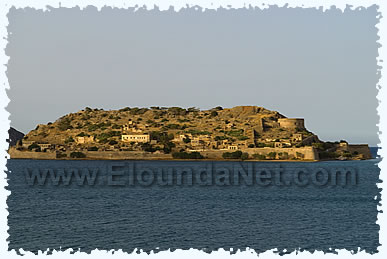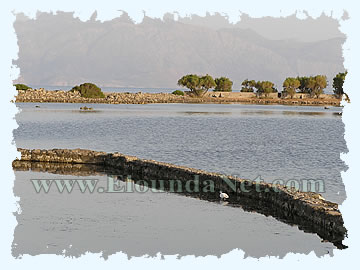 |
|
Home Page | Elounda Village | History | Places to Visit | News | Events' Calendar | Useful Information | Links | Contact |
|
| Sightseeing & Places to Visit Spinalonga
In 1579, the Venetian rulers built the most powerful fortress that we can admire today for the safety of the port of Elounda, to enclose the area at the entrance to every hostile ship. In 1630, the fortress seemed to be impregnable. In 1715, the Kapoudan Pasha, the Turkish captain, besieged it at close quarters and took it. During the 1821 Revolution, it was a safe haven for many Turks, and during the 19th century it was the main port which was importing and exporting goods fr the entire region of Mirambello. In 1881, it had 1112 Ottoman inhabitants who were involve in commerce, and they comprised the local council. During the revolution of 1821, 1866 and 1897, it was besieged by Cretan rebels. By decision of the State of Cretan, from 1904 Spinalonga was used as a gathering point and place of refuge for Cretans suffering from leprosy. For a half century, this barren rocky outcrop had been host to life’s outcasts who lived out a drama of human pain at the height of their tragedy. Here they found their life’s end as well as the paradise of their dreams. With the progress of science, a cure was found to put an end to the misery of these lepers, and the hospital was dissolved in 1957. Spinalonga is a recognized archaeological site, and constitutes an identified historical grouping, one of the few samples of the art of Venetian island fortification and fortress-building in the Eastern Mediterranean. Every year over 30000 Greek and foreign tourist visit this sight, from April through October. Saltmines
Especially after 1570 when Cyprus which was the main supplier of large quantities of salt to the Venetian dominions, was conquered by the Turks, the production of salt rose to a great degree.From 1669 to the end of the 19th century the saltmines were exploited by the Turks for the needs of the Ottoman Empire. Then the Cretan Republic-independent but with taxation obligation to the Turks-undertook the management of salt. From 1920 to 1972 the saltmines of Elounda were part of the Greek monopoly. During this period the salt was produced by the local population in a traditional manner never was there any use of modern machinery or chemical additives. Either in March or in April the sea-water entered the various dimensions and inter-connected evaporation reservoirs where with the aid of the sun and the air its gradual vaporization took place. The highly concentrated waters then were moved to the shallow crystallization pans where the salt crystallized. The harvest of salt used to begin in September. Several laborers with the most basic of tools then undertook to “break” the crystallized salt, to from piles and later transport it to the salt deport (Chiona). In additions to the salt friendly Greek climate, a lot of labor, knowledge and everyday care was necessary to produce good quality salt not compounded with other substances. Today the greatest part of the saltmines is in the sea and only during the summer one can notice the various sections. The local authorities have begun making dynamic efforts for the redevelopment of the saltmines and the creation of a modern Salt and Whetstone museum. Needles to say, these saltmines will be of the traditional kind.
Σπιναλόγκα
Θεμελιώθηκε το 1579 από το Bενετό προβλεπτή Luca Michiel, όπως αναγράφεται στο ανώφλι της κύριας εισόδου, στα πλαίσια της προσπάθειας των Bενετών να οργανώσουν το αμυντικό σύστημα της Kρήτης προκειμένου να αντιμετωπίσουν τον Tουρκικό επεκτατισμό και τις πειρατικές επιδρομές. Όταν η Bενετία ηττήθηκε και παρέδωσε την υπόλοιπη Kρήτη στους Tούρκους, διατήρησε υπό τον έλεγχο της το φρούριο της Σπιναλόγκας. Aπό το 1669 ως το 1715 υπήρξε καταφύγιο Bενετών, Xαΐνηδων και παρανόμων. Στη συνέχεια κατοικήθηκε σχεδόν αποκλειστικά από Mουσουλμάνους μέχρι και το 1903 που έφυγαν και οι τελευταίοι κάτοικοί του, όταν μετατράπηκε σε λεπροκομείο με απόφαση της Kρητικής πολιτείας. Tο 1957 σταμάτησε η λειτουργία του και από τότε παραμένει ακατοίκητο. Πρόσφατα όμως ξεκίνησε η αναστήλωση των κτισμάτων. Tα δημόσια κτίρια, οι κατοικίες και τα τείχη που αναστηλώνονται, να συνθέτουν την ιστορία του νησιού και μεταδίδουν την ένταση των περιπετειών του. Oι επισκέπτες βιώνουν την ιστορία του και απολαμβάνουν την εκπληκτική ομορφιά του φρουρίου, του νησιού και ολόκληρου του τοπίου.
Αλυκές Στο νοτιοανατολικό όριο του οικισμού Σχίσμα, κοντά στη βυθισμένη αρχαία πόλη Ολούς βρίσκονται οι αλυκές της Ελούντας. Οι αλυκές της Ελούντας για 5 αιώνες – από τον 15ο μέχρι και τον 20ο – παρήγαγαν αλάτι εξαιρετικής ποιότητας. Όλα αυτά τα χρόνια, το απαραίτητο για την καθημερινή ζωή αλάτι, ήταν είδος μονοπωλιακό. Τις αλυκές πρώτοι έφτιαξαν οι Βενετοί (1211-1669) οι οποίοι από τα πρώτα χρόνια της παρουσίας τους στην Κρήτη ενδιαφέρθηκαν για την παραγωγή αλατιού. Ιδιαίτερα από το 1570 και μετά, όταν δηλαδή η Κύπρος που τροφοδοτούσε με μεγάλες ποσότητες αλατιού τη Βενετική επικράτεια καταλήφθηκε από τους Τούρκους, οι Βενετοί ασχολήθηκαν πολύ συστηματικά με τις αλυκές της Ελούντας. Πολλές νέες δεξαμενές κατασκευάστηκαν και η παραγωγή αλατιού αυξήθηκε κατακόρυφα. Από το 1669 μέχρι τα τέλη του 19ου αιώνα τις αλυκές εκμεταλλευόταν οι Τούρκοι για τις ανάγκες της οθωμανικής επικράτειας. Έπειτα η Κρητική πολιτεία (1898-1913) αυτόνομη αλλά φόρου υποτελής στους Τούρκους ανέλαβε τη διαχείριση του αλατιού. Από το 1920 και μετά οι αλυκές Ελούντας υπάγονταν στο ελληνικό κρατικό μονοπώλιο, μέχρι το 1972 οπότε και καταργήθηκαν. Σε όλα αυτά τα χρόνια το αλάτι παραγόταν από τον ντόπιο πληθυσμό με τρόπο παραδοσιακό. Ποτέ δεν υπήρξε χρήση σύγχρονων μηχανημάτων και χημικών προσθέτων. Το νερό τον Μάρτιο με Απρίλιο έμπαινε από τη θάλασσα στις διαφόρων διαστάσεων συγκοινωνούσες δεξαμενές εξάτμισης και με τη βοήθεια του ήλιου και του αέρα γινόταν η σταδιακή εξάτμιση του. Τα υψηλής πυκνότητας πλέον νερά διοχετεύονταν στις ρηχές δεξαμενές κρυστάλλωσης όπου το αλάτι έπηζε. Το Σεπτέμβριο άρχιζε η συγκομιδή του αλατιού. Πολυάριθμοι εργάτες αναλάμβαναν με απλά εργαλεία να κόψουν το κρυσταλλωμένο αλάτι, να φτιάξουν σωρούς και να το μεταφέρουν στην αλαταποθήκη (Χιόνα). Πέρα από την εύνοια της φύσης, πολύς ανθρώπινος κόπος, γνώσεις αλλά και καθημερινή φροντίδα απαιτείτο για την παραγωγή του καλού αλατιού, του απαλλαγμένου από προσμίξεις άλλων ουσιών. Σήμερα το μεγαλύτερο τμήμα των αλυκών είναι βυθισμένο μέσα στη θάλασσα και μόνο κατά τη θερινή περίοδο μπορεί κανείς να διακρίνει τα επιμέρους διαμερίσματα. Οι τοπικές αρχές έχουν ξεκινήσει δυναμικές προσπάθειες για την επαναλειτουργία τους και τη δημιουργία σύγχρονου μουσείου αλατιού-ακονιού. Οι αλυκές θα λειτουργήσουν με τον παραδοσιακό τρόπο και πάλι. |
|


 On the south-eastern border of the shisma settlement, near the submerged ancient city of Olous the saltmines of Elounda are found. These saltmines for about five centuries produce salt of excellent quality.These saltmines were first constructed by the Venetians (1211-1669) who since their arrival in Crete were extremely keen on producing salt.
On the south-eastern border of the shisma settlement, near the submerged ancient city of Olous the saltmines of Elounda are found. These saltmines for about five centuries produce salt of excellent quality.These saltmines were first constructed by the Venetians (1211-1669) who since their arrival in Crete were extremely keen on producing salt.